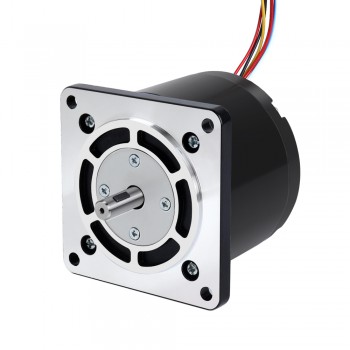1.Definition
A variable reluctance stepper motor is a motor whose rotor is made of ferromagnetic material. When the stator is energized, it becomes an electromagnet and the rotor feels a pull in the specified direction. Ferromagnetic materials always try to adjust themselves in the path of minimum magnetic resistance. By energizing the coil, a magnetic field is generated and the air gap magnetic resistance is changed. This type of motor is called a variable reluctance stepper motor. In this type of motor, the direction of the motor is independent of the direction of the current in the winding. The rotor of a variable reluctance stepper motor (VR stepper motor) is made of soft magnetic material and has no permanent magnets. The stator coil generates a magnetic field that attracts the rotor teeth and causes the rotor to move step by step.
2.Common types of faults
1.Abnormal operation: This may be caused by improper driver parameter settings, poor connection between the motor and the driver, or motor failure. To solve this problem, you need to check whether the driver parameter settings are correct, whether the connection between the motor and the driver is good, and whether the motor is faulty.
2.Loss of step: This means that the actual position of the motor is inconsistent with the command position during operation. The reason for the loss of step may be due to excessive motor load, insufficient drive current, improper setting of the drive subdivision number, etc. The solution to this problem is to reduce the motor load, increase the drive current, adjust the drive subdivision number, etc.
3.Excessive noise: It may be caused by motor bearing wear, bad gears, poor connection between the motor and the drive, etc. In order to reduce noise, it is necessary to check the condition of the motor bearings and gears to ensure that they are in good working condition, and check whether the connection between the motor and the drive is good.
4.Heat: It may be caused by excessive motor load, excessive drive current, poor motor heat dissipation, etc. In order to avoid overheating of the motor, it is necessary to reduce the motor load, adjust the drive current, strengthen the heat dissipation of the motor, etc.
3.Maintenance and maintenance methods
1.Cleaning: Clean the stepper motor regularly to remove dust and dirt and keep the motor clean. Use vinegar or gasoline to wipe the inside and outside of the motor, and pay special attention to protect the motor from physical damage
2.Lubrication: Lubricate the bearings and other moving parts of the stepper motor regularly to reduce friction and wear. Use special lubricating oil or grease, and ensure that the bearings are fully lubricated.
3.Parts replacement: Regularly check the parts of the stepper motor, such as the synchronous belt, gears and controller, and replace them in time if they are damaged or aged. It is recommended to use original accessories to avoid incompatibility issues that may be caused by using non-original parts.
4.Storage conditions: If the stepper motor is not used for a long time, it should be stored in a dry, dust-free environment to prevent moisture and dust from damaging the motor. During storage, it is recommended to turn the motor regularly to ensure its flexibility.
5.Regular operation: Even if it is not used frequently, the stepper motor should be run for a period of time regularly to maintain its performance and flexibility. This helps prevent the motor from degrading due to long-term non-use.
6.Avoid overload: Make sure the load of the stepper motor is within the recommended range and avoid long-term overload operation to prevent overheating and damage to the motor.
7.Professional operation: It is not recommended to repair or adjust the stepper motor by yourself unless you are an experienced technician. You should seek the help of professionals to ensure proper maintenance and extend the service life.
4.How to choose the right model
1.Torque selection: Choose the right motor model according to the required torque size (i.e. the torque size of the object to be driven). Generally speaking, if the torque is below 0.8N.m, you can choose 20, 28, 35, 39, 42 (the diameter or squareness of the motor body, unit: mm); if the torque is around 1N.m, it is more appropriate to choose a 57 motor; if the torque is several N.m or more, you should choose a stepper motor with specifications such as 86, 110, 130, etc. 2.Speed selection: The output torque of the motor is inversely proportional to the speed. At low speed, the output torque of the motor is large; while at high speed, the torque will decrease. Choose the right motor according to the needs of the working environment. If a high-speed motor is required, a motor with a slightly smaller inductance should be selected to obtain a larger output torque.
3.No-load starting frequency selection: The no-load starting frequency of the stepper motor is an important indicator, especially in applications that require instantaneous frequent starting and stopping. If you need to start directly to achieve high-speed operation, you should choose a motor with a higher no-load starting frequency, such as a reactive or permanent magnet motor.
4.Phase number selection: Motors with different phase numbers have different working effects. The more phases, the smaller the step angle can be made, and the vibration during operation is relatively smaller. In most occasions, two-phase motors are used more. However, in high-speed and high-torque working environments, three-phase stepper motors are more practical.
5.Use environment: Select according to the use environment of the motor. For example, special stepper motors that are waterproof and oil-proof are suitable for some special occasions, such as underwater robots, etc.
